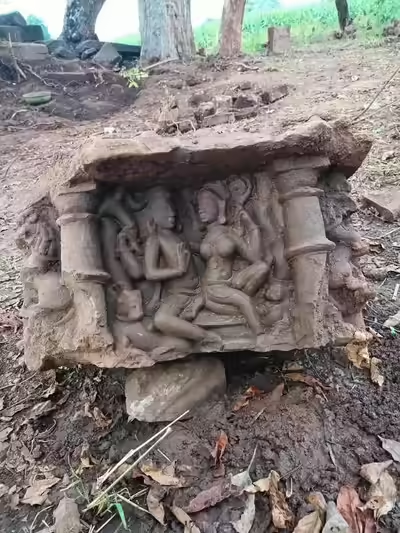Madhya Pradesh
10th-Century Idols Unearthed in MP
- 09 Oct 2025
- 4 min read
Why in News?
Archaeologists have unearthed 15 rare 10th-11th century idols in Doni village, Damoh, Madhya Pradesh, showcasing the rich temple art of the Kalachuri era.
- The discovery has stunned experts and could rewrite the history of medieval temple art in central India.
Key Points
- About: A team led by PC Mahobiya, deputy director of the State Archaeology Department, North Zone, Gwalior, has been working since April 2025 to excavate the site.
- The idols, carved from red sandstone, are a mix of well-preserved deities, including rare representations like Ardhanarishvara and Narasimha.
- The discovery of exceptionally well-preserved artefacts has garnered significant attention from historians and scholars, marking a valuable contribution to Madhya Pradesh's cultural heritage.
- Discovered Artefacts:
- Narasimha Idol: A half-human, half-lion Narasimha idol was found, with the upper portion intact but the lower half damaged.
- Ardhanarishvara Idol: A unique composite form of Shiva and Parvati, with Nandi carrying Parvati, which is extremely rare.
- Other Idols: Additional idols include Brahma, Vayu, Nayika, and Parvati, each in remarkable detail.
- Significance: These idols provide a glimpse into the temple art and religious symbolism of the Kalachuri era, adding depth to the understanding of medieval Hindu sculpture.
- The uniqueness of the Ardhanarishvara idol, where Nandi is shown carrying Parvati, challenges traditional representations and opens new avenues for academic exploration.
- The red sandstone sculptures, some potentially worth crores in the international antiquities market, are significant not only for their cultural value but also for their monetary worth, raising concerns about preservation.
Kalachuri Dynasty
- Origin of the Kalachuris: The Kalachuris, also known as the Haihayas, are believed to have originated from a Kshatriya tribe.
- They are mentioned in Brahmanical epics and Puranas. The early Kalachuris, or those of Mahishmati, ruled regions in present-day Gujarat, Madhya Pradesh, and Maharashtra.
- Early Rulers: Notable early rulers include Krishnaraja, Shankaragana, and Buddharaja (550-620 CE). Despite their initial rise, the Kalachuris struggled against the powerful neighboring kingdoms of the Chalukyas of Vatapi and the Maitrakas of Valabhi, leading to their decline.
- Matrimonial Alliances: To strengthen their position, the Kalachuris maintained matrimonial relations with the eastern and western Chalukyas. These alliances played a significant role in their political survival, even after military defeats.
- Kalachuris of Chedi: The Kalachuris of Chedi, with their capital at Tripuri (now Jabalpur), rose to prominence in the 9th century CE.
- Kokalla I was the first significant ruler of this branch, known for defeating Pratihara emperor Bhoja I and Rashtrakuta king Krishna II, which led to matrimonial relations with the Rashtrakutas.
- Royal Patronage to Religion: The Kalachuris, especially Yuvaraja I, were strong patrons of Brahmanical religion, with a special focus on Shaivism.
- They made numerous land grants for religious establishments, and Yuvaraja I supported Shaivite saints like Durvasa, who established the Golakimatha monastery.
- The Kalachuris supported diverse religious practices, including Shaivism, Shakti worship, Jainism, and Buddhism.
- The Yogini cult, prevalent during this time, is seen in temples at Khajuraho, Bheraghat, and Shahdol.







